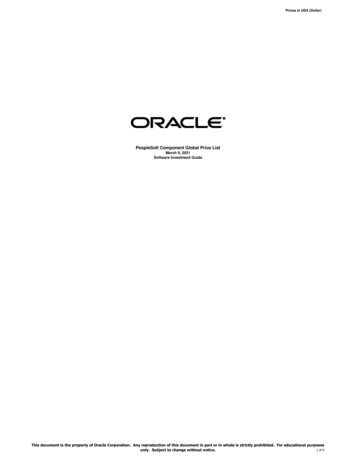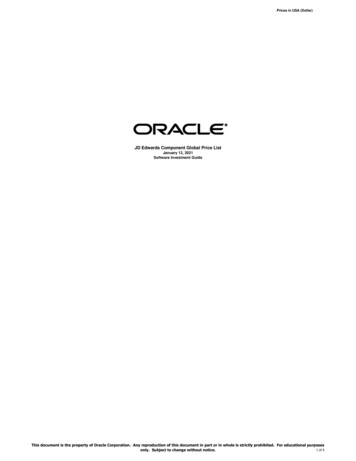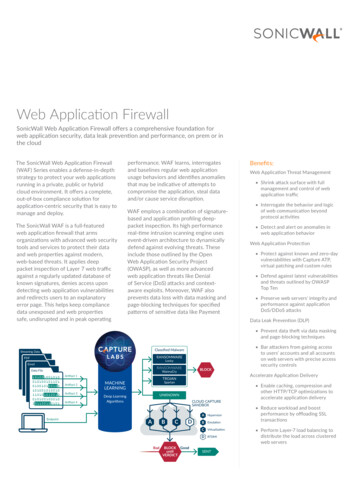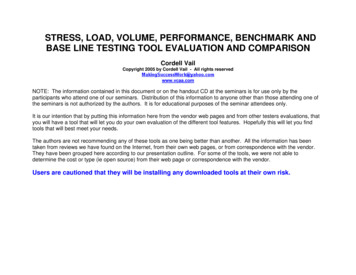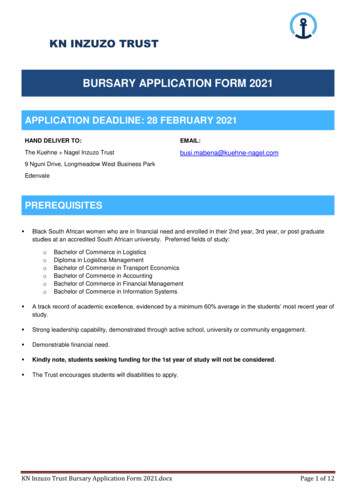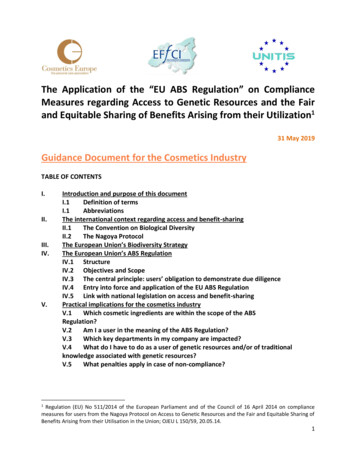
Transcription
The Application of the “EU ABS Regulation” on ComplianceMeasures regarding Access to Genetic Resources and the Fairand Equitable Sharing of Benefits Arising from their Utilization131 May 2019Guidance Document for the Cosmetics IndustryTABLE OF CONTENTSI.II.III.IV.V.Introduction and purpose of this documentI.1Definition of termsI.1AbbreviationsThe international context regarding access and benefit-sharingII.1The Convention on Biological DiversityII.2The Nagoya ProtocolThe European Union’s Biodiversity StrategyThe European Union’s ABS RegulationIV.1 StructureIV.2 Objectives and ScopeIV.3 The central principle: users’ obligation to demonstrate due diligenceIV.4 Entry into force and application of the EU ABS RegulationIV.5 Link with national legislation on access and benefit-sharingPractical implications for the cosmetics industryV.1Which cosmetic ingredients are within the scope of the ABSRegulation?V.2Am I a user in the meaning of the ABS Regulation?V.3Which key departments in my company are impacted?V.4What do I have to do as a user of genetic resources and/or of traditionalknowledge associated with genetic resources?V.5What penalties apply in case of non-compliance?1Regulation (EU) No 511/2014 of the European Parliament and of the Council of 16 April 2014 on compliancemeasures for users from the Nagoya Protocol on Access to Genetic Resources and the Fair and Equitable Sharing ofBenefits Arising from their Utilisation in the Union; OJEU L 150/59, 20.05.14.1
ANNEXESAnnex 1Annex 2Annex 3Annex 4Annex 5Annex 6I.Examples of conditions for the applicability of the EU ABS RegulationCase studies focusing on R&D activities that are either or not considered as‘utilisation’ in the meaning of the EU ABS RegulationExample of template stating a supplier’s compliance with due diligenceFlowchart illustrating the due diligence compliance processExamples of terms and elements typically included in Mutually Agreed Terms(MAT)Examples of monetary and non-monetary benefitsINTRODUCTION AND PURPOSE OF THIS DOCUMENTThe cosmetics industry fully supports the objectives of the Convention2 on Biological Diversity3(the Convention) and of the Nagoya Protocol4, the international instrument adopted on 29October 2010 by the Parties to the Convention.It also welcomes the EU ABS Regulation which establishes rules governing compliance with accessand benefit-sharing for genetic resources and traditional knowledge associated with geneticresources, in accordance with the Nagoya Protocol.The purpose of this document is to help companies and associations in the cosmetics industryunderstand the requirements of the EU ABS Regulation and to provide practical guidance,wherever possible. This is a ‘living document’ which will evolve as knowledge and experience aregained through the application of the Regulation.This document has been developed by Cosmetics Europe, the Personal Care Association, incooperation with EFfCI, the European Federation of Cosmetic Ingredient Suppliers and UNITIS,the European Organisation of Cosmetic Ingredients Industries and Services.It represents the three associations’ current understanding of the Regulation’s requirementsand is expected to evolve as these requirements are further clarified, e.g. through furtherguidance issued by the European Commission.The reader should note that interpretation of the EU ABS Regulation by national CompetentAuthorities may vary and may, in some cases, be different from the guidance provided in thisdocument, e.g. regarding derivatives and in particular those that are chemically modified. Thereader is therefore advised to check national rules and requirements before accessing geneticresources and/or traditional knowledge.2www.cbd.intApproved on behalf of the European Union in accordance with Council Decision 93/626/EEC of 25 October 1993concerning the conclusion of the Convention on Biological Diversity (OJEU L 309, 13.121993, p.1)4Annex I to Document UNEP/CBD/COP/DEC/X/1 of 29 October 2010, approved on behalf of the European Union inaccordance with Council Decision 2014/283/EU of 14 April 2014 (OJEU L 150, 20.05.2014, p. 231).32
I. 1Definition of TermsFor the purposes of this document, the definitions listed in the Convention and the NagoyaProtocol, as well as the EU ABS Regulation 511/2014 apply.Out of these, the definitions that are the most relevant for this document are listed below.Additional definitions are provided in, or derived from, the European Commission’s ‘HorizontalGuidance’5, and they are indicated by ‘*’.ACCESS: the acquisition of genetic resources or of traditional knowledge associated with geneticresources in a Party to the Nagoya Protocol.ASSOCIATION OF USERS: an organisation, established in accordance with the requirements of theMember State in which it is located, that represents the interests of users and that is involved indeveloping and overseeing the best practices.BIOTECHNOLOGY: any technological application that uses biological systems, living organisms, orderivatives thereof, to make or modify products or processes for specific use.COLLECTION: a set of collected samples of genetic resources and related information that isaccumulated and stored, whether held by public or private entities.COMMODITY*: a genetic resource, such as agricultural, fisheries or forestry product which istraded or exchanged for direct consumption or as an ingredient, but for which no utilisation takesplace.COUNTRY OF ORIGIN*: the country which possesses the genetic resources in in-situ conditions.DATE OF ACCESS: the date of acquisition of genetic resources and/or of traditional knowledge asdetermined by the national legislation of a provider country that exercises sovereign rights overits natural resources.DERIVATIVE*: a naturally occurring biochemical compound resulting from the genetic expressionor metabolism of biological or genetic resources, even if it does not contain functional units ofheredity.GENETIC MATERIAL: any material of plant, animal, microbial or other origin containing functionalunits of heredity.GENETIC RESOURCE (or “GR”): a genetic material of actual or potential value.5European Commission Notice: Guidance document on the scope of application and core obligations of Regulation(EU) No 511/2014 of the European Parliament and of the Council on the compliance measures for users from theNagoya Protocol on Access to Genetic Resources and the Fair and Equitable Sharing of Benefits Arising from theirUtilisation in the Union, OJEU C 313, 27.8.2016 [a.k.a. “Horizontal Guidance”]3
ILLEGALLY ACCESSED GENETIC RESOURCE: genetic resource and traditional knowledge associatedwith a genetic resource which were not accessed in accordance with the national access andbenefit-sharing legislation or regulatory requirements of the provider country which is a Party tothe Nagoya Protocol requiring prior informed consent.IN-SITU CONDITIONS: conditions where genetic resources exist within ecosystems and naturalhabitats, and, in the case of domesticated or cultivated species, in the surroundings where theyhave developed their distinctive properties.INTERNATIONALLY RECOGNISED CERTIFICATE OF COMPLIANCE: a permit or its equivalent issuedat the time of access as evidence that the genetic resource it covers has been accessed inaccordance with the decision to grant prior informed consent, and that mutually agreed termshave been established for the user and the utilisation specified therein by a competent authorityin accordance with Article 6(3)(e) and Article 13(2) of the Nagoya Protocol, that is made availableto the Access and Benefit-Sharing Clearing House established under Article 14(1) of that Protocol.MUTUALLY AGREED TERMS (or “MAT”): the contractual agreements concluded between aprovider of genetic resources, or of traditional knowledge associated with genetic resources, anda user, that set out specific conditions for the fair and equitable sharing of benefits arising fromthe utilisation of genetic resources or of traditional knowledge associated with genetic resources,and that may also include further conditions and terms for such utilisation as well as subsequentapplication and commercialisation.PARTY6: a state or an organisation (e.g. the European Union) which has formally expressed itsconsent to be bound by the Nagoya Protocol by means of a ratification, approval, accession oracceptance instrument.PRIOR INFORMED CONSENT7 (or “PIC”): an administrative permit given by the competentauthority of a provider country to a user, prior to accessing genetic resources. The term is alsoused to indicate the right of indigenous and local communities to make a free and informed choiceon whether they wish to give access to genetic resources or traditional knowledge associated withgenetic resources.PROVIDER COUNTRY*: the country of origin of the genetic resource or any (other) Party to theProtocol that has acquired the genetic resource in accordance with the Convention.RESEARCH & DEVELOPMENT8* (or “R&D”): for the purposes of the EU ABS Regulation theinterpretation should be based on their ordinary meaning in the context they are used and in the6Additional information can be found at: http://www.cbd.int/world/ratification.shtmlSee the EC’s Glossary available sity/international/abs/material esearchandexperimentaldevelopment6thedition.htm4
light of the purpose of the Regulation. Examples can be found in the EC Horizontal Guidance andthis guidance document for the cosmetics industry.TRADITIONAL KNOWLEDGE ASSOCIATED WITH GENETIC RESOURCES (or “TK”): traditionalknowledge held by an indigenous or local community that is relevant for the utilisation of geneticresources and that is as such described in the mutually agreed terms applying to the utilisation ofgenetic resources.USER: any natural or legal person that utilises genetic resources or traditional knowledgeassociated with genetic resources. [See also ‘utilisation of genetic resources’]UTILISATION OF GENETIC RESOURCES: to conduct research and development on the geneticand/or biochemical composition of genetic resources, including through the application ofbiotechnology.SUBSEQUENT USER*: a natural or legal person who receives a material, which is subject tocontractual obligations entered into when the material was accessed and utilises it in the contextof the Regulation.I. 2AbbreviationsThe following abbreviations are used throughout this document (also see the correspondingdefinitions in Section I.1 above):EC: European CommissionEU: European UnionGR: genetic resource(s).PIC: prior informed consent.MAT: mutually agreed terms.R&D: research and development.TK: traditional knowledge associated with genetic resources.II.THE INTERNATIONAL CONTEXTII.1The Convention on Biological DiversityOpened for signature at the Earth Summit in Rio de Janeiro in 1992, and entered into force on 29December 1993, the Convention on Biological Diversity (CBD) is an international treaty with 3main objectives:the conservation of biodiversity,the sustainable use of the components of biodiversity,the equitable sharing of the benefits derived from the use of GR.5
The Convention seeks to address all threats to biodiversity and ecosystem services includingthreats from climate change, through scientific assessments, the development of tools, incentivesand processes, the transfer of technologies and good practices and the full and active involvementof relevant stakeholders including indigenous and local communities, youth, NGOs, women andthe business community. It is therefore also considered as a tool for economic development.For further information on the Convention please visit www.cbd.intII.2The Nagoya ProtocolThe Nagoya Protocol is an international agreement on Access to Genetic Resources and the Fairand Equitable Sharing of Benefits Arising from their Utilisation. It aims at preserving biologicaldiversity, promoting the sustainable use of its components and sharing the benefits arising fromthe utilisation of GR in a fair and equitable way.It was adopted by the Conference of the Parties on 29 October 2010 in Nagoya, Japan and itimplements the 3rd objective of the Convention on Biological Diversity (CBD).With 53 ratifications at the time, the Nagoya Protocol entered into force on 12 October 2014.For further information please visit the following website: http://cbd.int/absIII.THE EUROPEAN UNION’s BIODIVERSITY STRATEGYOn 3 May 2011, the EC adopted a new strategy to halt the loss of biodiversity and improve thestate of EU species, habitats, ecosystems and services by 2020 (hereinafter “EU 2020 BiodiversityStrategy”’)9. This strategy was partly the result of failure of previous EU biodiversity policies inreaching their targets (e.g. the establishment of Natura 2000, the world’s largest network ofprotected areas) and partly due to international commitments made by the EU and its MemberStates at the tenth Conference of the Parties (COP10) to the Convention on Biological Diversityheld in Nagoya in 2010. In particular, the COP10 led to the adoption of a global strategic plan forbiodiversity 2011-2020 incorporating a 2050 vision, a 2020 mission and 20 targets10 (the so-called“Aichi Biodiversity targets”). The EU 2020 Biodiversity Strategy incorporates some of the globaltargets. It is developed around six targets covering the following:1.2.3.9full implementation of EU nature legislation;better protection and restoration of ecosystems and the services they provide, andgreater use of green infrastructure;more sustainable agriculture and forestry;Communication of 3 May 2011 from the Commission to the European Parliament, the Council, the Economic and Social Committee and theCommittee of Regions entitled “Our life insurance, our natural capital: an EU biodiversity strategy to 2020” available DF/?uri CELEX:52011DC0244&from EN10 A summary of the 20 targets is available at: http://www.cbd.int/sp/targets/default.shtml6
4.5.6.better management of EU fish stocks and more sustainable fisheries;tighter control on invasive alien species; andgreater EU contribution to averting global biodiversity loss.Implementation of the Nagoya Protocol is mentioned as one of the key actions to provide agreater EU contribution to averting global biodiversity loss11 as required by the global target12.On 21 June and 19 December 2011, the Council adopted its conclusions 13 approving the EC’sBiodiversity Strategy until 2020. Specifically, the Council welcomed that the strategy respondedto obstacles that prevented previous EU targets being achieved. These obstacles includedinsufficient integration of biodiversity protection in other EU policies, inadequate funding, policygaps as well as knowledge and data gaps. The conclusions also highlighted the need to integratebiodiversity objectives into relevant sectorial policies, such as the Common Agricultural Policy,the common fisheries policy and EU cohesion policy and, inter alia, called for a quick adoption bythe EC of a proposal for the timely ratification and implementation of the Nagoya Protocol.On 20 April 2012, the EU Parliament adopted a resolution14 which mostly welcomed the EC’sBiodiversity Strategy pointing nonetheless out that the major challenge would be the integrationof biodiversity in all policy fields and translations of action plans in concrete legislative measures.In 2015, the EC published a mid-term review of the Biodiversity Strategy to 2020. Overall,biodiversity loss and the degradation of ecosystem services in the EU have continued since theEU 2010 biodiversity baseline. This is consistent with global trends and has serious implicationsfor the capacity of biodiversity to meet human needs in the future. While many local successesdemonstrate that action on the ground delivers positive outcomes, these examples need to bescaled up to have a measurable impact on the overall negative trends.IV.THE EU ABS REGULATIONThe EU ABS Regulation implements at EU level the requirements of the Nagoya Protocol imposingupon the Parties (i) to ensure that users of GR comply with the relevant legislation of the providercountries of such resources in terms of PIC and MAT setting out the sharing of benefits and (ii) tomonitor obligations by requesting evidence of compliance by users of GR or TK associated withthem at specific checkpoints or by carrying out compliance checks.It is up to each EU Member State in the exercise of its sovereign rights over its own resources15to establish the specificities of the terms of access and benefit-sharing, if any.11Target 6.12Target 16 of the Aichi Strategy.13Available at: ?uri CELEX:52011DC0244&from EN andhttp://register.consilium.europa.eu/doc/srv?l EN&f ST%2011978%202011%20INIT14Available at: y/comm2006/pdf/EP resolution april2012.pdf15See Article 15(1) of the CBD.7
Note: Provider countries of GR or of TK associated to such resources are free to decide whetherthey want to establish access legislation or not. If they decide not to introduce any rules, accessto their GR is considered to be free. However, EU Member States have the obligation to designatecompetent authorities to monitor the compliance with the EU ABS Regulation in their countriesand to define and apply sanctions in case of non-compliance.Certain requirements – regarding the Register of Collections, Due Diligence Declarations and BestPractices – are further detailed in the EC’s Implementing Regulation16.IV.1StructureThe EU ABS Regulation is divided into three main Chapters:CHAPTER I: subject matter, scope and definitions;CHAPTER II: user compliance;CHAPTER III: final provisions.Chapter I clarifies the nature of the ABS Regulation as a set of rules governing compliance withaccess and benefit-sharing requirements (if any) for GR and TK associated with such resources. Italso describes the scope of the Regulation and provides a list of relevant definitions. For furtherdetails, see section IV.2 below.Chapter II is the core part of the ABS Regulation focusing on the “due diligence” concept. Inpractice, it enumerates users’ obligations for being compliant with local access legislation andbenefit-sharing mechanisms, where relevant. Moreover, this chapter clarifies how compliancechecks may be conducted at Member State level and defines general criteria for penalties. Forfurther details, see section IV.3 below.Chapter III contains provisions on cooperation between national competent authorities and withthe EC, complementary measures to be adopted by the EC and the Member States to facilitateand boost compliance with the ABS Regulation, committee procedure for the adoption ofimplementing acts by the EC and the establishment of a consultation forum to discuss issuesrelated to the implementation of the Regulation. Lastly, this Chapter clarifies the report andreview procedures to be followed by Member States and the EC17 respectively, as well as theentry into force of the Regulation.IV.2Objectives and ScopeObjectives16Commission Implementing Regulation (EU) 2015/1866 of 13 October 2015 laying down detailed rules for theimplementation of Regulation (EU) No 511/2014 of the European Parliament and of the Council as regards theregister of collections, monitoring user compliance and best practices, OJEU L 275, 20.10.201517Member States must report to the EC on the application of the ABS Regulation by 11 June 2017 and at five-year intervals after that date. TheEC must report to the EU Parliament and Council on the effectiveness of the Regulation one year later and every 10 years after its first report.8
The EU ABS Regulation brings the EU in line with the international commitments undertakenthrough the Convention on Biological Diversity and the Nagoya Protocol, namely the contributionto the conservation of biological diversity and sustainable use of its components and a frameworkensuring that GR and TK associated with such resources are accessed in compliance with theprovider country’s requirements on access and benefit-sharing (if any).ScopeThe EU ABS Regulation applies to GR over which States exercise sovereign rights and to TKassociated with such resources that are accessed and used after the entry into force of the NagoyaProtocol for the Union (12 October 2014) and to which access and benefit-sharing legislation orregulatory requirements of a Party to the Nagoya Protocol are applicable. Articles 4 (obligationsof users), 7 (monitoring user compliance) and 9 (checks on user compliance) entered into forceone year later, on 12 October 2015.The requirements of the EU ABS Regulation apply to users of GR and of TK associated with GR,namely to their acquisition (after 12 October 2014) when and only if combined with R&Dactivities (utilisation) on the genetic and/or biochemical composition of such GR, includingthrough the application of biotechnology.For the EU ABS Regulation to apply, the following cumulative conditions must be met: material scope: The EU ABS Regulation applies to the utilization of GR and/or TKassociated to GR; geographic scope: the EU ABS Regulation applies to the utilization in the EU of GR and/orassociated TK from Parties to the Nagoya Protocol with access legislation in place; temporal scope: the GR must have been accessed on or after 12 October 2014 and afterthe entry into force of the ABS legislation of the provider country.The EU ABS Regulation does not apply to GR for which the access and benefit-sharing is governedby specialized international instruments that are consistent with, and do not run counter to, theobjectives of the Convention and the Nagoya Protocol18, e.g. the International Treaty on PlantGenetic Resources for Food and Agriculture (ITPGRFA).In addition, the EU ABS Regulation does not concern trade and exchange of commodities. As longas no R&D is carried out on commodities entering the EU, the EU ABS Regulation does not apply.If and when R&D is carried out on commodities in the EU, there is a change in their status as theyare no longer commodities but GR, and they become subject to the EU ABS Regulation. In thiscase, users are expected to contact the provider country and clarify whether PIC and MAT arerequired. The EC Horizontal Guidance recommends to those who are planning to carry out R&D18See Article 2.2 of Regulation (EU) 511/2014).9
on commodities, to access the resources directly from the provider country so that theprovenance is clear as well as the applicability of the Protocol19/of the EU ABS Regulation.Note: Human GR are excluded from the scope of the Nagoya Protocol as well as GR obtained fromareas beyond national jurisdictions (e.g. high seas)20.As regards TK associated to GRs, they must be related to the utilization of GRs and must becovered by the relevant contractual agreements21.Please see Annex 1 which provides some theoretical illustrative examples of scenarios that areeither in or out of the scope of the EU ABS Regulation and Annex 2 which aims to help clarify thescope of utilisation (R&D) through some theoretical case studies.IV.3The central principle: users’ obligation to demonstrate due diligenceIV.3.1 Due Diligence ObligationsTo ensure the effective implementation of the EU ABS Regulation – and thus of the NagoyaProtocol – all users of GR and TK associated with GR must exercise due diligence to ascertain thatGR and TK associated with them have been accessed in accordance with applicable legal orregulatory requirements of the provider country. They must also ensure that, where relevant,benefits are fairly and equitably shared.The exercise of due diligence involves the collection, retention and transmission to subsequentusers of a specific set of information.IV.3.1.1Information to be collected, kept and transferredUsers shall exercise due diligence when accessing and utilising GR and TK associated withsuch resources to make sure that they were accessed and utilised in accordance with theapplicable PIC and MAT requirements of the provider country.In particular, users must seek, keep (for 20 years after the end of the period of use of theGR or of the TK) and transfer to subsequent users the following information 22: the internationally-recognised certificate of compliance, as well as information onthe content of the MAT relevant to subsequent usersor, where the internationally-recognised certificate is not available, information andrelevant documentation on:19See the EC Horizontal Guidance, page 7.See Recital (8) of the EU ABS Regulation.21See the EC Horizontal Guidance, page 7.22See Article 4.3 of the CM-ABS Regulation.2010
the date and place of accessing the GR or the TK associated with GR;the description of the GR or of TK associated with GR utilised;the source from which the GR or TK associated with GR was directly obtained, aswell as subsequent users of GR or TK associated with GR;the presence or absence of rights and obligations relating to access and benefitsharing, including rights and obligations regarding subsequent applications andcommercialisation;access permits, where applicable;MATs, including benefit-sharing arrangements, where applicable.As a general rule, a user needs to check that the information in his or her possession issufficient and does not give rise to doubts about the legality of the access and utilisation.Given that many uncertainties23 persist in some national legislations, users are advisedto document the due diligence process very carefully.Otherwise, users must either obtain the missing information or discontinue theutilisation of the GR and/or the TK associated with GR.Suppliers who have performed R&D on the GR should provide their customers who buythe product developed via the utilisation of the GR with a statement of compliance (seeAnnex 3) indicating that the GR utilised has been legally accessed. If further R&D activityis to be carried out by their customers on the GR, suppliers will transfer the required setof information and documentation as specified above.Users acquiring a GR from a collection included in the Register of Collections within theEU, referred to in Article 5.1 of the EU ABS Regulation, are considered to have exerciseddue diligence as regards the seeking of information required under Article 4.3 of thisRegulation24. Nevertheless, users have to check whether their planned R&D activities arecovered by the conditions of use of GR and/or TK described. If this is not the case, usershave to exercise their due diligence obligations.Users also have an obligation to declare to the national Competent Authorities that they exerciseddue diligence.23“(.) it is widely recognized that the level of national ABS implementation is low and often incomplete. Countrieshave reached different levels of implementation and have adopted different approaches to regulation, reflectingtheir national administrative structures, priorities, and cultural and social realities. Some countries have only adoptedone measure – generally legislation – while others have adopted a package of measures such as a national strategy,legislation or regulations and guidelines. However, many countries do not have a complete system because legislativeor administrative developments at different levels of government (e.g., regional, national/federal andstate/provincial level) are ongoing.” (CISDL, Swiss Federal Office for the Environment, Overview of national andregional measures on access and benefit sharing: challenges and opportunities in implementing the Nagoya Protocol,third edition, 25 June 2014)24See Article 4.7 of the EU ABS Regulation.11
In this context, and where available, national Competent Authorities must accept internationallyrecognised certificates of compliance (IRCC) as evidence that the GR covered were legallyaccessed and that MAT were established for the user and the utilisation specified therein.The due diligence obligation also requires users, in case the intended use of a GR changes, to seeknew (or modify the previous) PIC from the provider country and establish MAT for the new use.If a GR is transferred, this should be done in accordance with the MAT, which may imply the entryinto the contract by the transferee.For further details on users’ obligations, please see section V.4 and the flowchart in Annex 4.IV.3.1.2Due Diligence DeclarationsThe EC has provided a web-based application (DECLARE) to allow users' submission of DueDiligence Declarations online. The manual for users of DECLARE provides explanations for its use.IV.3.1.2.1 At the stage of research funding“Funding for research” means any financial contribution by means of a grant to carry outresearch, whether from commercial or non-commercial sources.Recipients of funding for research (or project coordinators in case the same researchproject involves more than one recipient or is funded from more than one source)involving utilisation of GR and TK associated with GR, shall make a due diligencedeclaration to the competent authority of the Member State in which the recipient (orthe project coordinator) is established; if the recipient (or the project coordinator) is notestablished in the EU and the research is conducted in the EU, the due diligencedeclaration shall be made to the competent authority of the Member State in which theresearch is carried out.The declaration shall be made after the first instalment of funding has been received andall the GR and TK that are utilised have been obtained, but no later than at the time ofthe final report or, in the absence of such report, at the end of the project.Annex II of the Implementing Regulation provides the template to be used for thisdeclaration.IV.3.1.2.2 At the stage of final development of a productThe concept of “stage of final developmen
May 31, 2019 · the European Organisation of Cosmetic Ingredients Industries and Services. . 4 Annex I to Document UNEP/CBD/COP/DEC/X/1 of 29 October 2010, approved on behalf of the European Union in accordance with Council Decision 2014/28






